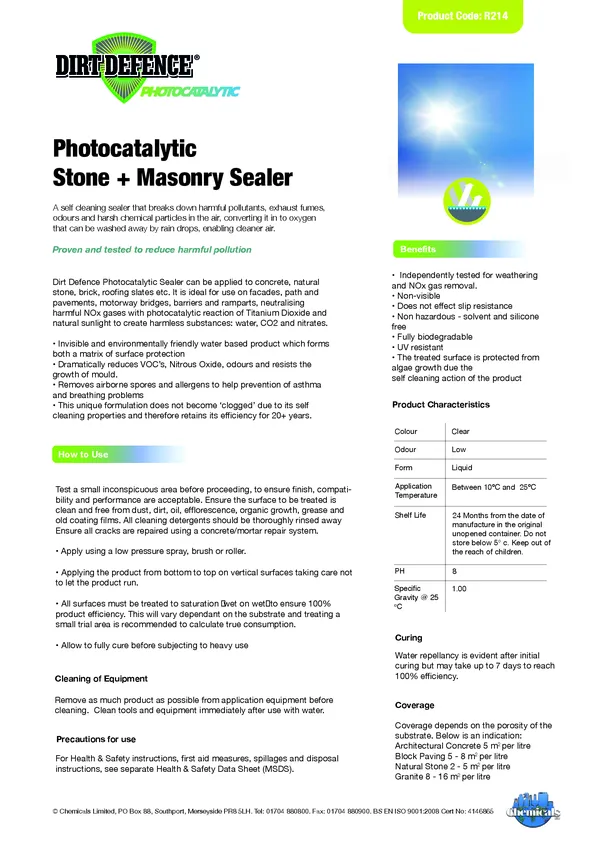R214 Photocatalytic Air Purification Sealer Datasheet


R214 Photocatalytic Air Purification Sealer
Photocatalytic Stone + Masonry Sealer A self cleaning sealer that breaks down harmful pollutants, exhaust fumes, odours and harsh chemical particles in the air, converting it in to oxygen that can be washed away by rain drops, enabling cleaner air.
Dirt Defence Photocatalytic Sealer can be applied to concrete, natural
stone, brick, roofing slates etc. It is ideal for use on facades, path and
pavements, motorway bridges, barriers and ramparts, neutralising
harmful NOx gases with photocatalytic reaction of Titanium Dioxide and
natural sunlight to create harmless substances: water, CO2 and nitrates.
- Invisible and environmentally friendly water based product which forms both a matrix of surface protection
- Dramatically reduces voc’s, nitrous oxide, odours and resists the growth of mould.
- Removes airborne spores and allergens to help prevention of asthma and breathing problems
- This unique formulation does not become ‘clogged’ due to its self cleaning properties and therefore retains its efficiency for 20+ years.
Test a small inconspicuous area before proceeding, to ensure finish, compatibility and performance are acceptable. Ensure the surface to be treated is
clean and free from dust, dirt, oil, efflorescence, organic growth, grease and
old coating films. All cleaning detergents should be thoroughly rinsed away
Ensure all cracks are repaired using a concrete/mortar repair system.
- Apply using a low pressure spray, brush or roller.
- Applying the product from bottom to top on vertical surfaces taking care not to let the product run.
- All surfaces must be treated to saturation ‘wet on wet’ to ensure 100% product efficiency. This will vary dependant on the substrate and treating a small trial area is recommended to calculate true consumption.
- Allow to fully cure before subjecting to heavy use
| Parameter | PAT1-2 Sample | Market Leading |
| Presence of smooth regions with cracks corresponding to coating film | Yes | Yes |
| Likelihood of encountering coating film with a Ti content more than 1 wt.% | Higher | Lower |
| Size of the areas covered coating film | Larger | Smaller |
| Detection of a region with no Ti content | No | Yes |
| Minimum Ti content detected (wt.%) | 0.6 | 0.0 |
| Maximum Ti content detected (wt.%) | 17.9 | 6.8 |
| Average Ti content of scanned areas (wt.%) | 3.8 | 1.2 |
| Presence of small needleshaped features | Yes | No |
| Evidence of good correlation between Ti and Si distributions | Yes | No |
| Possibility of pooling effect during coating | Yes | Yes |
